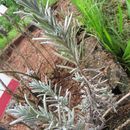Brief Summary
provided by IABIN
Diagnosis A minute short-legged but slender paludicoline with smooth, scantly glandular skin, Lacking inguinal or lateral glands, and enlarged glandular ridge venid the mout joint.
- author
- Esteban O. Lavilla
- editor
- Diego Arrieta
Distribution
provided by IABIN
Known from some localities in the provinces of Buenos Aires and Entre Ríos in Argentina and a few localities in the departments of Canelones, Florida, and Montevideo in Uruguay. The record for department of Rivera in Uruguay is in error.
- author
- Esteban O. Lavilla
- editor
- Diego Arrieta
Molecular Biology
provided by IABIN
Lavandulae flos, Princípio amargo essência, cumarina
Diagnostic Description
provided by IABIN
Adult morphology Snout-vent of about 17-22 mm in males, 17-26 mm in females. Head wider than large, rounded when seen in dorsal profile. Snout short, truncate in lateral profile, not protunding on the lower jaw. Sloping to meet the upper lip. Maxillary teeth developed; vomerine teeth absent. Tongue narrow, oval to spatulate, free and entire behind. Tympanum sljghtlv recognizable, not evident. Tympanic fold indistinct. Fingers rounded at the tip, free; rate of the finger lengths: I-II-IV-III. Subarticular and metacarpal tubercles rounded and weak. No antebrachid tubercles. Toes free: subarticular and metatarsal tubercles conical, moderate. A tarsal round tubercle at midway between the inner metatarsal tubercle and the hee1. No tarsal fold present. When hindleg is adpressed, heel reaches the shoulder. When the femurs are bent at right angles to body, the tibio-tarsal articulations overlap. Skin smooth, scantily glandular on the dorsum, very smooth on the belly. No inguinal glands; no lateral glandular present. Color brownish above, scattered with faintly brown spots or dots; ventrally whitish, closely speckled with pale dark blotches. Larval morphology Description is based on seven specimens at developmental stages 32-38 (Gosner, 1960). Size small, total length 26.84 mm (±1.92), body length (8.73±0.84) one-third of total length; body shape oval, body length 50-60% of body height (4.96±0.60), and body width (5.23±0.32) 80-100% of body height, without constrictions between head and trunk; snout rounded in dorsal and lateral profile; eyes relatively large, dorsolaterally placed; eye diameter (1.21±0.11) 27-28% of body width at eye level (4.34±0.42), and 87-93% of interorbital distance (1.39±0.10); interorbital distance 29-32% of body width at eye level; rostro-orbital distance 5.86±0.26. Nostrils subcircular, dorsal, elevated, closer to tip of snout than to eye, nostril diameter (2.76±0.4) 13-14% of body width at nostril level, rostronasal distance (0.71±0.11) 55-61% of orbitonasal distance (1.06±0.14); nostril diameter (0.37±0.06) 37-45% of internarial distance (0.94±0.10), and internarial distance 66-73% of interorbital distance; extranarial distance (1.55±0.10) 45-47% of extraorbital distance (3.37±0.23). Spiracle sinistral, spiracular tube and opening lateral, spiracular opening rounded, rostro-spiracular distance (5.86±0.26) 63-71% of body length. Vent tube length (2.08±0.75) 14-29% of body length; vent opening medial. Tail length (15.79±1.57) 59-63% of total length, tail height at the base of the tail 5.39±0.55, tail height at the tip of the caudal musculature 0.70±0.26; dorsal and ventral fins well developed, with slightly curved margins; maximum tail height approximately at middle length and lower than body height; tail axis straight and tip of tail rounded. Caudal musculature height at the base of the tail (2.74±0.36) 55-56% of body height, caudal musculature width at the base of the tail 2.51±0.27; myotomes clearly visible, the posteriormost ones not reaching the end of the tail. Oral disc sub-terminal, not visible dorsally; oral disc width 1.91±0.14, disc small, about 36-38% of maximum body width; disc with angular constrictions; an irregular double row of triangular and rounded marginal papillae in lateral regions; small mental gap present (0.43±0.11); with medium-sized rostral gap (1.16±0.08), about 61% of oral disc width; intramarginal papillae absent; tooth row formula 2(2)/3(1), rostrodonts well developed and keratinized, margins serrated; keratodonts spatulated and serrated. One specimen bears small keratodonts on the marginal papillae. Coloration: In life, dorsum and lateral body sides uniformly greyish, darker dorsally than laterally; ventral region grey, peribranchial zone paler than abdominal region, abdomen rich in guanophores producing silvery and golden sheens; fins scantily pigmented, transparent, and dotted with few irregular rows of melanophores; caudal musculature darker with melanophores arranged more densely than on fins. In preservative, creamy white tail with few isolated brown spots more abundant in the hypaxial musculature. Body darker than tail, dorsally dark-brown, ventrally pale brown. Intestinal mass visible through transparency.
- author
- Esteban O. Lavilla
- editor
- Diego Arrieta
Conservation Status
provided by IABIN
LC. Least Concern. Cited how "Atención Especial" in Uruguay.
- author
- Esteban O. Lavilla
- editor
- Diego Arrieta
Physalaemus fernandezae: Brief Summary
provided by wikipedia EN
Physalaemus fernandezae is a species of frog in the family Leptodactylidae. It is found in Argentina, Uruguay, and possibly Brazil. Its natural habitats are subtropical or tropical seasonally wet or flooded lowland grassland, intermittent freshwater marshes, and rocky areas. It is threatened by habitat loss.
- license
- cc-by-sa-3.0
- copyright
- Wikipedia authors and editors

